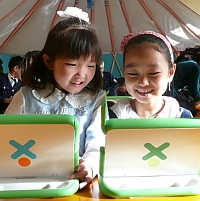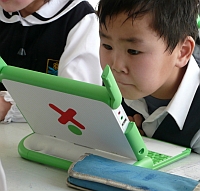In this week's Community News, Walter Bender enlightens us on how the OLPC Mongolia implementation team -
Enkhmunkh Zurgaanjin, Carla Gomez Monroy, Jan Jungclaus, and David Woodhouse -are working both sides of the one laptop per child challenge: technology and education.
First, David, with remote support from John Watlington in OLPC Cambridge are having fun getting WiFi meshing through the tick, concrete walls of Soviet constriction:
The servers we shipped from Cambridge have arrived and are being installed. David has been handling the difficult task of positioning two servers (with six antennae) to cover a three-floor school. He is also facing the need to upgrade the laptops right away to avoid a networking meltdown...Despite the -31C temperature (better known as "damn cold"), they are making connectivity progress. The school now has an optical-fiber cable connecting it to the Internet.Hopefully, the nature of the mesh will improve coverage. To start with, each school will have five antennae, with two servers. That setup will be re-evaluated when it's fully deployed and tested in the classrooms. It is physically installed in one school so far, and fully cabled (including CAT5 to the other rooms where they have computers). The other school should be similarly set up by the end of Monday
Over in the educational sphere, One Laptop Per Child is engaging the Mongolian Ministry of Education to try and institutionalize OLPC learning systems:
We met yesterday with the Ministry of Education team, teachers, principals, ICTA, content team and pilot research team to provide detailed feedback of how the project is going so far and to bring up things to be considered for the short and long terms.By the look of the children on the OLPC Wiki, there is definitely support for XO laptops in the land of the Khan.Teachers are putting their hearts into the program. They had their first sessions with the children. Parents, too, have shown support. And the children, of course, love it. The Constructionist model of learning has found wide-spread support within the MoE.




Beginner in OLPC, interested in growth of an idea. Thanks for asking.
They say a picture speaks a thousands words! After seeing those smiles and the light in the eyes of the children all the debate just fades away as unimportant!
A friend of mine, Dewayne Hendricks, helped set up wireless networks in Ulaan Bataar in the 90's, and he was surprised that the point to point connections went right though the buildings. Why? They had not use rebar! Good for wireless, not so good during earthquakes.
My 7-year-old son had no problem suring the Sugar UI metaphors without any real instructions, and it really surprised me. So I can imagine many local officials in Ulaan Bataar have been surprised also.
The OLPC is the only project that might be able to reach the nomadic children in Mongolia. A yurt often has some ways of low power electricity, and sometimes even a dish. Mesh could be used for delayed store and foreward protocols.
But things like a Classmate will be a lost cause. "More teachers" is inconceivable, unless you extend the periods children have to be in boarding schools.
Winter
Winter,
A way, Maybe not the "ONLY" way -
http://www.hole-in-the-wall.com/News11.html
Another way with documented results -
http://www.hole-in-the-wall.com/Findings.html
Since you're using few computers you need even less electricity.
"Since you're using few computers you need even less electricity."
The problem is not soo much the electricity, but the way these people roam around the country. They live in tents (yurts) which have to be packed on horses. A HiW project will not reach many children.
These are Nomadic people with a big N. Around 30% are still (semi-)nomadic, although the last few winters have decimated their livestock:
http://en.wikipedia.org/wiki/Mongolia
The story of the Weeping camel gives a (romanticized) peek into their lives:
http://www.youtube.com/watch?v=LpYXK-7szd8
Winter
Winter wrote: "They live in tents (yurts) which have to be packed on horses. A HiW project will not reach many children."
What about a HiY (Hole in a Yurt) or a SPiT (Solar Projector in a Tent)? OLPC (and M.L.J.) could design appropriate screens or rollable electronic papers for such projects.
"What about a HiY (Hole in a Yurt) or a SPiT (Solar Projector in a Tent)? OLPC (and M.L.J.) could design appropriate screens or rollable electronic papers for such projects."
The problem is not technological, but social, as far as I know (which isn't far).
The Mongolian nomades often live in rather small groups, even single families. There will not be enough children to justify a HiW project of any kind. But a single XO might indeed go a long way even for such a small group (siblings) of children.
Of course, someone who actually knows how these people live and what they want should comment. I only know them from TV. Not really a trustworthy source.
Winter
Winter wrote :
> The problem is not technological, but social,
> as far as I know (which isn't far).
OLPC is partly, as far as I know, a technological solution
to a social problem (the lack of educational infrastructures).
> But a single XO might indeed go a long way
> even for such a small group (siblings) of children.
Yes, a single XO so they can learn together,
but with a bigger screen so they can gather around it.
A rollable screen would be great for nomads.
For what it's worth these students seem to be living in a city, not as nomads. They also seem to have infrastructure in place to support XO implementation--schools, teachers and electricity.
http://wiki.laptop.org/go/Ulaanbaatar (bottom of page)
The very last picture is a herdsman living in the country but they don't seem to have XOs, just the city kids.
Marc, I heard a story the other day about families (in India I think) gathering together to watch movies on a cellphone. I've seen groups of kids watching videos on ipods so I'd imagine the XO screen might not be too small, through a rollable screen would be way cool.
One thing not being considered here is that this might not be an XO problem but rather an XS problem. Since the XS mailing lists seem to be ever dead its all still entirerly speculation but an ITX based XS could run over ultra low power ie. a single 12volt solar sell with the proper transformer. If the unit is desgined with (marketing word filter on please) a rugged weatherized external case (filter off) the unit could be stowed like any peice of gear this might facilitate learning by the nomadic children. Linking said XS back into the net could be done via Skytel's 3G network which does cover a notable portion of the country could be utilized. Add in a download manager of your choice and the servers can download teaching materials as they go in and out of service range. Considering the XS does NOT have too be "clock stopping technology" just Functional, CHEAP, Small, Rugged, and have a low power consumption, this might be the solution to technological side of this problem, since every last bit of this could be done with OTS technologies all available right across the border from them in China(cough quanta cough cough).
Ned
"For what it's worth these students seem to be living in a city, not as nomads."
I know. I was trying to see what could be done for those 33% of the children that are underway during a large part of the year. The XO might even help them. Mongolian nomads do have electrical applyances, even satelite TV.
Winter
Mongolia can be split into two groups: 1) the majority of the population that live in the capital city UB and a small number of other major towns including the 21 aimag (province) capitals. 2) The remaining minority that live in the countryside.
These two groups have quite different problems as far as OLPCs. The centre of the major towns is Soviet era construction with all the amenities and problems that brings. The towns are surrounds (in the case of UB, engulfed) by suburbs of Gers - where the population have moved from the countryside to live on small patches of land in the traditional felt tents (they are not 'Yurts' - those are in Kyrgyzstan). The facilities (electricity, water, sanitation etc) available in these 'Ger Suburbs' varies greatly.
In the countryside, Gers are spread evenly but thinly across the countryside. In areas where the land is poor (edge of the Gobi) the space between Gers can be many miles, in fertile valleys neighbouring gers can be a stone's throw away.
Power within Gers are frequently supplied by way of a 12v solar panel running into an old car battery. Sunlight is not a problem in the land of the blue skies and I have frequently run low power laptop and charging equipment through power inverters in Gers. The XO would be no problem with the right converters. Even the poorest families will often have a small black and white TV, those with more money will have satelite and maybe a Video-CD or even a DVD player.
As for wireless, this is a country of wide open spaces so mesh networking between remote gers is a possibility, depending on the distance. Line of sight connections between Gers are quite possible (boosted with an aerial hanging from the solar panel which is frequently lifted up above head height on a support stand).
The air in Mongolia is very clear so this would be about the best signal propogation possible.
The greatest difficulty at the moment is the relatively poor (but rapidly improving) backbone internet connections to the aimag capitals. Until as recently as 2006, the capital of Bayan-Olgii aimag had no more than dial-up links to the capital.
You can see some photographs of Mongolia on a website for a charity event we organise. http://www.mongoliarally.com/
OLPC would be a project we would be interested in supporting through our rally and we've made some approaches in that regard.